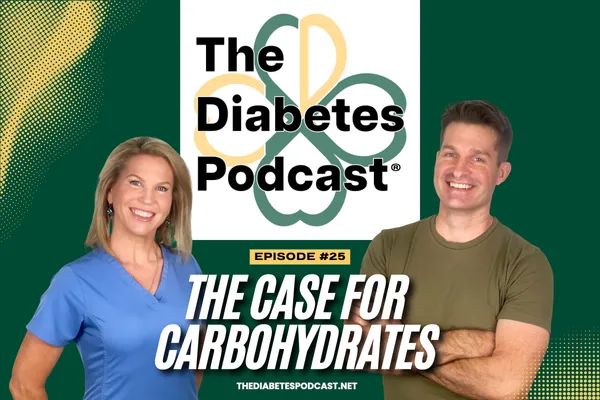
EP025 - The Case for Carbohydrates
Carbs aren’t the enemy—reclaim them for better diabetes health
"The scale drops fast on keto because you lose water, not fat."
Carbs have been called the enemy for years. In diabetes care, “diabetes low carbs” is everywhere. But the full story is bigger. Carbs are not villains. In fact, the right carbs are part of the best diets for health, performance, and longevity. Let’s break it down in clear, simple ways.
Keto: What It Is—and Why It Feels Like It “Works”
History: Keto began in the 1920s as a medical therapy for seizures in children—not a weight loss trend.
Fast results: When you cut carbs, you lose water weight fast. Glycogen (stored glucose) in your muscles holds water. As glycogen drops, water drops. The scale goes down, but it’s not fat loss at first.
Most people aren’t in ketosis: True nutritional ketosis means blood ketones ≥ 0.5 mmol/L—measured, consistently. Most “keto” diets are actually just low carb.
Why weight loss happens: Fewer choices, fewer treats, fewer ultra-processed foods = fewer calories. It’s not that carbs magically cause fat gain.
Ketones vs. Ketoacidosis: Important Safety Note
Ketones are normal sometimes (overnight, skipped meals). That’s okay.
Diabetic ketoacidosis (DKA) is dangerous. It can happen in type 1 and in undiagnosed type 2. Warning signs: extreme thirst, frequent urination, nausea, vomiting, deep/rapid breathing, fruity or nail polish remover breath. Go to the ER if this happens.
For insulin-dependent people, chronic keto can be risky. You may be closer to DKA if you get sick, get dehydrated, or miss insulin.
Why Going Very Low Carb Can Backfire
Physiological insulin resistance: When you avoid carbs for a long time, your muscles downregulate glucose transport. Then when you eat carbs, your blood sugar may spike higher and you may need more insulin proportionally. It’s an adaptation—but not ideal for flexibility.
Insulin-to-carb ratios can worsen: Some very low carb eaters need 1 unit insulin per 3–4 g carbs, while others who include carbs may need 1 unit per 12–15 g. That’s a big difference.
Metabolic Flexibility: Your Superpower
What it is: Your body’s ability to switch between fat and glucose for fuel smoothly.
Flexible looks like: You can skip a meal without crashing. You can eat beans and rice without wild spikes. You perform better during high-intensity activity (stairs, sprints) because muscles use glucose well.
How to build it:
Eat balanced: Include carbs, protein, and fat—don’t chronically restrict one macro.
Mix your training: Aerobic (walk, jog, cycle) + anaerobic (hills, sprints, strength).
What Carbs Bring to the Table (That Keto Often Doesn’t)
Fiber (only from plants):
Helps blood sugar control
Supports healthy cholesterol
Feeds the gut microbiome
Increases natural GLP-1 (helps fullness, appetite, and glucose)
Lowers colon cancer risk
Vitamins and minerals: B vitamins, folate, magnesium, potassium, manganese—abundant in whole grains, beans, fruits, and veggies.
Phytochemicals (powerful plant protectors):
Flavonoids, polyphenols, carotenoids, anthocyanins, resveratrol, quercetin
Strong antioxidants and anti-inflammatories
About 90% of these disease-fighting compounds come from carbohydrate-rich plant foods
Bottom line: Cut carbs and you often cut fiber, minerals, and the very compounds that fight inflammation and chronic disease.
High-Fat, Low-Carb and Longevity: The Long Game
Diets high in saturated fat often raise LDL cholesterol and heart risk.
Large studies (Nurses’ Health Study, EPIC, PURE) show longer life with plant-forward, carb-inclusive diets.
Animal-heavy protein correlates with higher mortality compared with plant protein.
The longest-living populations (Blue Zones) eat diets rich in plant-based carbohydrates.
So…What Should People With Diabetes Eat?
The most researched, sustainable, and heart-friendly eating patterns are all carb-inclusive:
Mediterranean diet:
Fruits, veggies, whole grains, beans, nuts, olive oil, and some fish
Linked to lower heart disease, cancer, and longer life
DASH diet:
Veggies, fruits, low-fat dairy, beans, whole grains
Best evidence for lowering high blood pressure—great for diabetes plus hypertension
Whole food plant-based:
Focus on unrefined plant carbs: beans, lentils, peas, whole grains, fruits, vegetables, nuts, seeds
Strong data for improving diabetes, heart health, and sometimes reversal of related conditions
Important note on sodium: Most sodium comes from ultra-processed foods. Cut these and your sodium drops—helpful for blood pressure and heart health.
Don’t Hate the Macro—Change the Source
Carbs aren’t the problem. Refined junk is the problem.
Think: soda, candy, pastries, chips, white flour foods, added sugars, and ultra-processed snacks.
Whole carbohydrate-rich foods—berries, apples, oats, quinoa, brown rice, beans, lentils, chickpeas, sweet potatoes, carrots, broccoli—support blood sugar, gut health, and inflammation control.
Simple Weekly Action Step
Step 1: Take inventory. Where does ultra-processed food sneak in? Morning sweet coffee drink? Afternoon chips? Nighttime ice cream?
Step 2: Swap one thing. Replace it with a high-fiber, whole-food carb:
Fruit: berries, apple, orange, pear
Non-starchy veggies: carrots, peppers, cucumbers, tomatoes, leafy greens, broccoli, cauliflower
If you’re ready for more: add beans or lentils to one meal, or switch to oats at breakfast
Key Takeaway
Carbs don’t need defending. They need reclaiming. When you choose whole, colorful, plant-based carbohydrate foods, you choose fiber, vitamins, minerals, and hundreds of phytochemicals your body needs to fight inflammation and insulin resistance. The most proven diets for diabetes and longevity are not “diabetes low carbs.” They are carb-smart, plant-forward, and sustainable.
Better question for your next meal: What whole, colorful, carbohydrate-rich food can I add to my plate today?
If you found this helpful, subscribe to The Diabetes Podcast. We’ll keep bringing clear science, practical tips, and real steps toward putting type 2 diabetes into remission. If you need additional help, contact us at [email protected].
Disclaimer
The information in this blog post and podcast is for educational and informational purposes only. It is not medical advice, diagnosis, or treatment, and it does not replace a one-on-one relationship with your physician or qualified healthcare professional. Always talk with your doctor, pharmacist, or care team before starting, stopping, or changing any medication, supplement, exercise plan, or nutrition plan—especially if you have diabetes, prediabetes, heart, liver, or kidney conditions, or take prescription drugs like metformin or insulin.
Results vary from person to person. Examples, statistics, or studies are shared to educate, not to promise outcomes. Any discussion of medications, dosing, or side effects is general in nature and may not be appropriate for your specific situation. Do not ignore professional medical advice or delay seeking it because of something you read or heard here. If you think you are experiencing an emergency or severe side effects (such as persistent vomiting, severe diarrhea, signs of dehydration, allergic reaction, or symptoms of lactic acidosis), call your local emergency number or seek urgent care right away.
We strive for accuracy, but health information changes over time. We make no guarantees regarding completeness, timeliness, or suitability of the content and assume no liability for actions taken or not taken based on this material. Use of this content is at your own risk.
Links or references to third-party resources are provided for convenience and do not constitute endorsement. By reading, listening, or using this information, you agree to these terms and understand that you are responsible for your own health decisions in partnership with your licensed healthcare provider.

